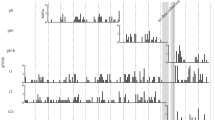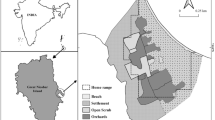Abstract
Data on grooming in a colony of 38 captive Macaca fascicularis were collected over a period of 6 months. The goal was to investigate how five social parameters (age, kinship, sex, grooming frequency, and relative rank) influenced the choice of body part being groomed. Age and kinship did not have systematic effects of grooming site preferences. The sex composition of individual dyads and the frequency at which grooming occurred were the factors with the greatest effect on body sites groomed among adults. Relative to other dyad types, male-male dyads almost never groomed on the face, avoided the front side of the trunk, and preferred the tail and back. Dyads that groomed relatively infrequently also favored the tail and avoided the face, chest, and belly. Relative rank had an effect on the body sites groomed among adult females: a groomer ranking lower than her partner groomed more often on the face, chest, and belly than a groomer ranking higher than her partner. Several hypotheses are discussed in the context of these results. The only one that explains most of the major results is that recipients of grooming expose relatively invulnerable parts of their bodies (i.e., back and tail) to and avoid eye contact with groomers that are relatively dangerous.
Similar content being viewed by others
References
Altmann, J. (1974). Observational study of behavior: Sampling methods.Behaviour 49: 227–265.
Baker, R. J. and Nelder, J. A. (1978).The GLM System, Release 3, Numerical Algorithms Group, Oxford.
Barton, R. A. (1983). A comparative study of grooming interactions in primates.Dodo. J. Jersey Wildl. Preserv. Trust 20: 26–36.
Barton, R. (1985). Grooming site preferences in primates and their functional implications.Int. J. Primatol. 6: 519–532.
Boccia, M. L. (1983). A functional analysis of social grooming patterns through direct comparison with celf-grooming in rhesus monkeys.Int. J. Primatol. 4: 399–418.
Boccia, M. L. (1986). Grooming site preferences as a form of tactile communication and their role in the social relations of rhesus monkeys. In Taub, D. M., and King, F. A. (eds.),Current Perspectives in Primate Social Dynamics, Van Nostrand Reinhold, New York, pp. 505–518.
Boccia, M. L., Rockwood, B., and Novak, M. A. (1982). The influence of behavioral context and social characteristics on the physical aspects of social grooming in rhesus monkeys.Int. J. Primatol. 3: 91–108.
Boccia, M. L., Reite, M., and Laudenslager, M. (1989). On the physiology of grooming in a pigtail macaque.Physiol. Behav. 45: 667–670.
de Waal, F. B. M., and Luttrell, L. (1985) The formal hierarchy of rhesus monkeys: An investigation of the bared-teeth display.Am. J. Primatol. 9: 73–86.
Dixson, A. F., Scruton, D. M., and Herbert, J. (1975). Behaviour of the talapoin monkey (Miopithecus talapoin) studied in groups, in the laboratory.J. Zool. Lond. 176: 177–210.
Gouzoules, S., and Gouzoules, H. (1986). Kinship. In Smuts, B. B., Cheney, D. L., Seyfarth, R. M., Wrangham, R. W., and Struhsaker, T. T. (eds.),Primate Societies, University of Chicago Press, Chicago, pp. 299–305.
Hutchins, M., and Barash, D. P. (1976) Grooming in primates: implications for its utilitarian function.Primates 17: 145–150.
McKenna, J. J. (1978). Biosocial functions of grooming among the common Indian languar monkey (Presbytis entellus).Am. J. Phys. Anthropol. 48: 503–510.
Seyfarth, R. M. (1977). A model of social grooming among adult female monkeys.J. Theor. Biol. 65: 671–698.
Walters, J. R., and Seyfarth, R. M. (1986). Conflict and cooperation. In Smuts, B. B., Cheney, D. L., Seyfarth, R. M., Wrangham, R. W., and Struhsaker, T. T. (eds.),Primate Societies, University of Chicago Press, Chicago, pp. 306–317.
Author information
Authors and Affiliations
Rights and permissions
About this article
Cite this article
Moser, R., Cords, M. & Kummer, H. Social influences on grooming site preferences among captive long-tailed macaques. International Journal of Primatology 12, 217–230 (1991). https://doi.org/10.1007/BF02547585
Received:
Revised:
Issue Date:
DOI: https://doi.org/10.1007/BF02547585




